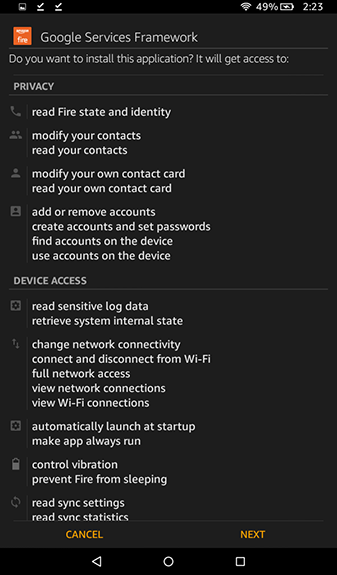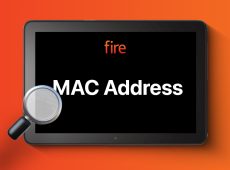Updated to include Fire HD 10 and Fire 8/8+ (10th Gen.) Tablets
Amazon Fire tablets are some of the best budget-friendly options on the market today that are worth recommending, thanks to Amazon’s great support and their excellent performance. While none of Amazon’s tablets are perfect, they represent fantastic value for your hard-earned cash.
The biggest limitation of Amazon’s tablets is the lack of app support for Google. While Fire tablets do run Android as their operating system, it’s actually a forked version of Android, custom-made by Amazon for their Fire tablets and streaming devices. For most consumers, Fire OS works similar to Android, but the center core of Google’s apps, including the entire line of Play apps, has been replaced by Amazon’s own app store.
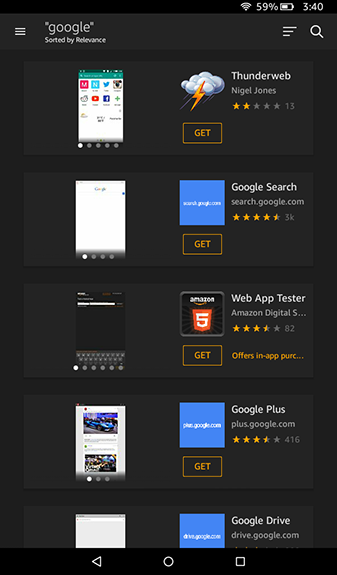
Apps like YouTube, YouTube Kids, Among Us, and more are not available in the Amazon App Store. Don’t fret about that issue, though, as you can easily sideload apps to Fire tablets.
Without YouTube Kids available on the Amazon Appstore, it might feel like you’re out of luck. Despite the Fire tablets’ adherence to Amazon’s own app ecosystem, it is possible to get the Play Store on your tablet, along with the standard suite of Google apps, including YouTube and YouTube Kids.
Here’s how to get YouTube Kids running on your Fire or Fire HD tablet.
Installing YouTube Kids on Fire Tablet: What You Need
Earlier Fire tablet models required the Play Store to be pushed to your device from a Windows computer using ADB, something that no longer has to be done. Instead, all you’ll need now is some rudimentary knowledge of how Android installs apps outside of the standard app store as well as some patience as your tablet downloads and installs all four required packages to run the Google Play Store properly.
To install YoutTube Kids and Google Play, you need the following:
- You need four separate Google APK files from APKMirror (linked below).
- Choose a Google account to use for the Play Store.
- Use an updated Fire tablet running Fire OS 5 or higher (for devices running 5.6.0.0, see Troubleshooting and Tips).
- Grab a file manager from the App Store (may be optional—see Troubleshooting and Tips).
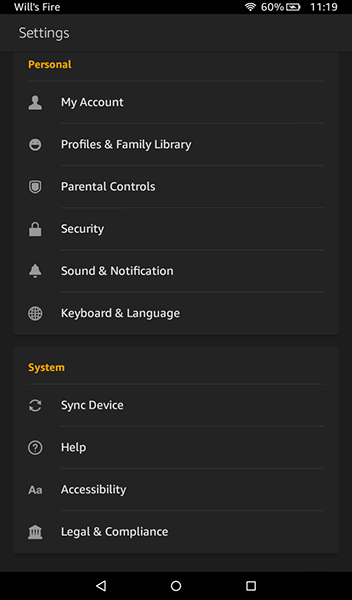
It’s also good to know which Fire Tablet you have before jumping into this guide.
Depending on the age of your tablet, you may need to download different apps than a device running older software.
- Head into the settings menu and select Device Options, then look for Device Model at the bottom of this guide.
This article uses the launch years of each tablet to help guide you towards the correct APK, so if you need help identifying what year your tablet came out, use Amazon’s Tablet Device Specs page right here. Knowing which generation your device belongs to will help a lot throughout this guide.
Enabling Apps from Unknown Sources on a Fire/Fire HD Tablet
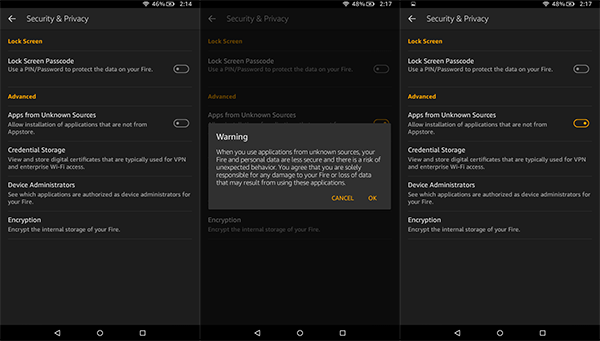
Alright, here’s where the real guide begins. The first thing we have to do on your Amazon Fire tablet is dive into the settings menu.
Despite Amazon’s modification to Android to create Fire OS, the operating system is actually incredibly similar to Google’s own, and that includes how third-party apps are installed outside of Amazon’s app store.
Enabling “Apps from Unknown Sources” on Fire/Fire HD Tablets
- Go to the Fire OS 7 app drawer by swiping up from the bottom, then select Settings.
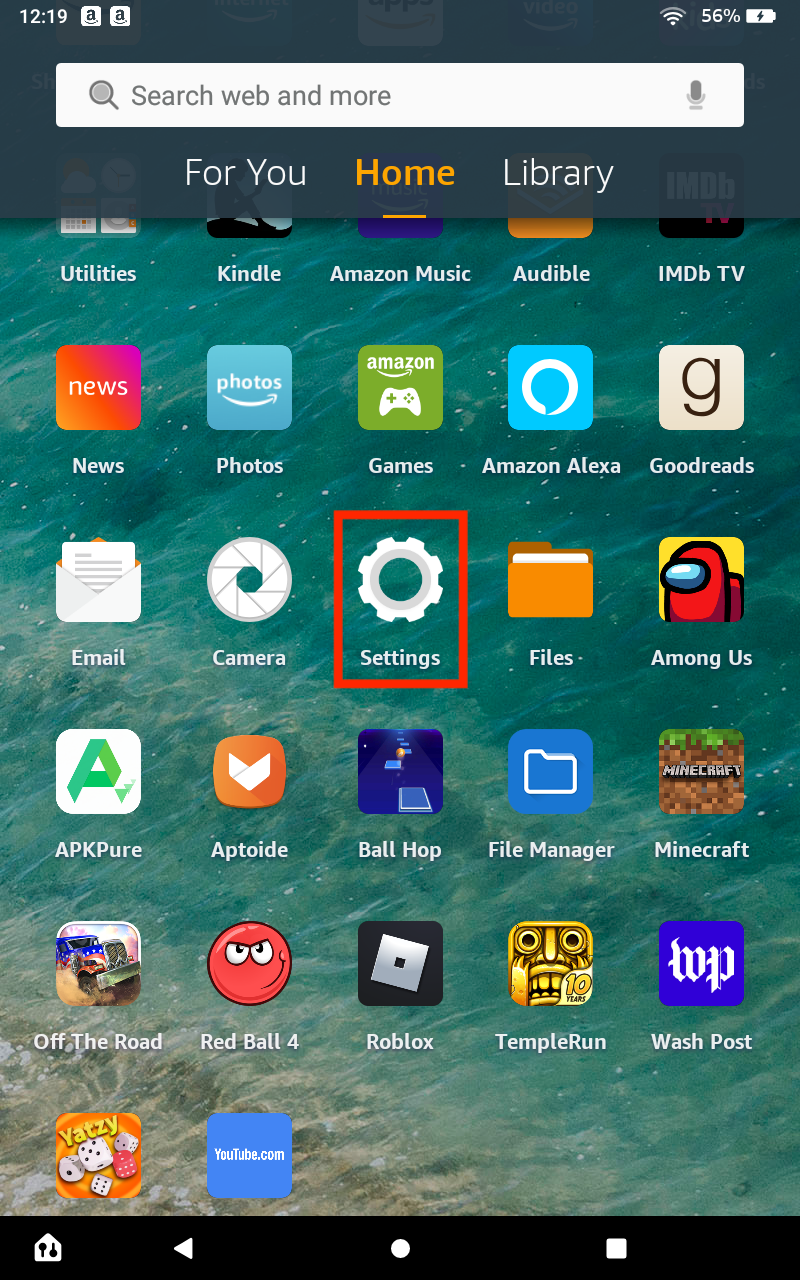
- Choose Security & Privacy.

- Toggle Apps from Unknown Sources to the On position.

- Verify that your source for installs is listed and set to Allowed.

Downloading and Installing the Google Play Store on Fire Tablet
Next up is the big part. On a standard Android tablet, installing apps outside of the Play Store would be as easy as installing the standard APK. Unfortunately, it’s not quite that easy on an Amazon Fire tablet. Since Google Play isn’t installed on your device, all apps sold through the Play Store won’t run without Google Play Services installed along with it since certain apps like Gmail and Google Maps check for authentication through that app.
This means you have to install the entire Google Play Store suite of services onto your device, which amounts to four different applications: three utilities and the Play Store.
The Google app versions you need for the utilities and the Play Store depend on the forked Android version used in Fire OS.
Identifying Your Fire OS Version and Forked Android Version of Your Fire/Fire HD Tablet
As Fire OS versions got upgraded, so did the Android versions used to develop them.
Here are a few of the most common Amazon Fire Tablets.
| Fire Tablet Version | Fire OS | Forked Android Version |
| Fire HD 10 | Fire OS 7 | Android 9 (API level 28) |
| Fire HD 8/8+ (10th Gen.) | Fire OS 7 | Android 9 (API level 28) |
| Fire HD 8 (8th Gen.) | Fire OS 6 | Android 7.1.2 |
Downloading the Google APK Files
When installing the necessary Google “apk” files, ensure you install them in the order listed below.
The four files include:
- Google Account Manager
- Google Services Framework
- Google Play Services
- Google Play Store
Again, it is best to download and install all four apk files in the exact order, and all of them can be downloaded using the built-in Amazon Silk browser. You should already have Unknown sources from the steps above set to Allowed for the Silk browser.
The site we’ll be using to download these APKs is called APKMirror. It’s a trusted source for free APKs from developers and Google Play and acts as a utility for any Android user looking to manually download or install apps. Every app held on APKMirror is free from the developer, without modifications or changes before being uploaded.
File 1 of 4: Download and Install Google Account Manager
The first app you need to download is Google Account Manager. This is more complex than it used to be because Amazon has updated the version of Android being used on their newer tablets.
Here are the two options, one of which is for your specific Fire/Fire HD tablet:
- If you’re using a Fire HD 10 tablet purchased on or after November 2019, Fire HD 8 purchased after October 2018, or a Fire 7 purchased after June 2019, your tablet is running Android 6.0 or above (See examples in the chart below). As such, you’ll want to use Google Account Manager 7.1.2 (Android 6.0+) for your tablet. 7.12 is the latest version of the application available on APKMirror, and has been since 2017; if a newer version becomes available, be sure to download that version instead.
- If you’re running a tablet purchased prior to October 2018, your tablet is still using Android 5.0, which means you’ll need version 5.1-1743759, which is the latest since April 2016. You can find that linked here.
- Find the correct Google Account Manager version based on the Android OS your Fire HD tablet/Fire OS used, which is one of the two options above. Click on the link to the apk’s download page.
- Review the details to confirm Android version compatibility, then click on the green downward arrow (Download APK) icon.
- A download prompt appears at the bottom of your display, and you can accept the prompt to begin the download.
- Once the download is complete, you’ll see a notification in your tray when you slide down from the top of your screen.
- Click on the apk file you just downloaded to install it, whether you click on the notification or the file in a file browser.
- Tap on Next on the bottom of the screen or scroll to the bottom to hit Install.
- If anything goes wrong during the installation, you’ll be alerted to the failure. If not, you’re done installing file 1 of 4! If it fails, move to Step 8.
- For installation failures, ensure you’ve downloaded the correct Android version of Account Manager (based on your Fire/Fire HD’s forked Android version), and the file should install. Newer versions will not install on the device.

File 2 of 4: Download and Install Google Services Framework
The next app is Google Services Framework. Just as with Account Manager, the version you need depends on the device you’re running. However, because of how Google’s framework app targets various versions of Android, it’s best to choose one that works on all Android versions.
- It is recommended that you download version 5.1-1743759 of Google Services Framework. This version is designed to run on ALL devices with Android 5.0 or higher, which means any Fire OS tablet can run it.
- Tap on the notification to start the installation process.
- Select Next to confirm you want to install Google Services Framework.

- If you’re prompted to update the app after installation, follow the prompts on your display to obtain the correct, newer version.
File 3 of 4: Download and Install Google Play Services
If you own a Fire 7 tablet purchased prior to June 2019—in other words, an 8th generation device or older—you should download this version here. That’s the APK meant for 32-bit processors, which your tablet is running. Amazon switched the Fire 7 to 64-bit processors with the ninth-generation model, but older devices will still need to download the correct version of the APK.
If you aren’t sure which version of the app you download, 32-bit versions are marked with a 020300 in the file name, while 64-bit versions are marked with a 020400. Both of these iterations of Google Play Services are identical in every way except for which type of processor they’re created for. If you download the wrong one, don’t stress too much. We’ll cover what to do in a moment below.
- Tap on the notification to start the installation process.
- Select Next to confirm you want to install Google Play Services.

File 4 of 4: Download and Install Google Play Store
The final of the four apps is the Google Play Store itself. This is the easiest of the four downloads, as all file versions work on Android 4.1 and above, and there aren’t separate types for different bit processors. Download the most recent version here.
For both Google Play Services and the Google Play Store, you should try to use the newest version of the app available. APKMirror will alert you when there is a newer version of the app available, which will be listed on the webpage below the information. For Google Play Services, you should avoid the beta versions of the app by looking for the most recent stable version on the list (beta versions are marked as such). For the Play Store itself, just download the most recent version. If you don’t feel comfortable figuring out which version listed on APKMirror is the correct version for your tablet, just download the linked versions, and Google Play will update the apps for you following a full install.
Installing the APK Files
Alright, once you’ve downloaded the four files listed above onto your Fire tablet using the Silk browser, swipe down from the top of the screen to open your notifications. You should see a full list of the APKs you downloaded in the last step, each with its own notification, sorted by time. If you followed the steps above and downloaded each in the proper order, the fourth download should be on the top of the list, and the first download on the bottom, so that the order appears as such:
- Google Play Store
- Google Play Services
- Google Services Framework
- Google Account Manager
- How you install these apps is very important, so start by tapping the Google Account Manager at the bottom of that list.
- The installation process will begin; hit Next on the bottom of the screen or scroll to the bottom to hit Install. Account Manager will begin to install on your device. If anything goes wrong during the installation, you’ll be alerted to the failure. Make sure you’ve downloaded the correct Android 5.0 version of Account Manager, and the file should install. Newer versions will not install on the device.
- Repeat this process for all three remaining apps in order, beginning with Google Services Framework, followed by Google Play Services and Google Play Store. When each app finishes downloading, a display will appear, citing the installation is complete.

- On both the Google Play Services and Google Play Store listings, there will be an option to open the app (on the Services Framework and the Account Manager apps, that option will be grayed out). Do not open these apps; instead, hit Done and continue following through on all four applications.
- As a final note, both Play Services and the Play Store take a bit of time to install, as they’re large applications. Allow the apps to install in their own time, and don’t try to cancel the installation or turn off your tablet. The entire installation process for all four apps should take no longer than about five minutes total.
If your version of Google Play Services fails to properly install, you may have downloaded the wrong version for your processor. Try downloading the other version before continuing with the guide.
Rebooting and Logging into Google Play
Once all four applications have been downloaded onto your tablet, you’ll need to restart it to finish the process.
- Press and hold the Power Button on your device until a prompt appears asking if you wish to turn off your tablet.
- After your device is powered off, reboot it by pressing and holding the power button again. When the tablet has booted back to your lock screen, we’re ready to finish the process by setting up Google Play.
- Head into your list of apps and select the Google Play Store from the list (do not select Google Play Services). Instead of opening up the store, it will open Google Account Manager in order to gain your Google account credentials. You’ll see a display showing the tablet is set up for use, and then Google will ask for your Gmail address and password.

- Finally, the device will ask if you wish to back up your account’s apps and data to Google Drive. Whether you wish to do so is up to you, but it’s not necessary for this step. All told, Google Play should take about two minutes total to finish installing. Once you’ve logged in and it’s completed the setup process, you’ll be dropped into the Google Play Store, the same app that is used on most Android devices.

Installing YouTube Kids
If you’ve used an Android device before, this is the easy part. Now that Google Play is installed on your tablet, it works just as it would for any other Android device.
- Open up the Play Store, search for YouTube Kids in the search bar along the top of the display, then select Install from the app’s listing.

Really, that’s it, no difficult workarounds, no plugging your tablet into a computer. As far as Google Play is concerned, your tablet is just another standard Android device. When you’ve finished downloading and installing the app on your tablet, it’ll work like any other app on your Fire. The app can be launched from your app drawer and will show up in your list of recent apps on the home screen, making it easy to access. On our test device, the app experience was identical to any other Android device, without any glitches.

Finally, though this should come as no surprise, YouTube Kids isn’t the only application that can be installed using this method. Any app that hasn’t been uploaded to Amazon’s own Appstore can be downloaded from your newly installed Play Store, just as on any other Android device.
Using Freetime (Child Profiles)
In recent builds of Fire OS, it seems that it is impossible to get the YouTube Kids app working on a Child profile (known as FreeTime in the Amazon ecosystem). As late as summer 2017, it was possible to enable “Install Apps from Outside Sources” under the Child profile to properly move the APK from your main user account to the secondary account, but according to the Amazon Fire subreddit, this feature was disabled in September 2017.
Without the ability to enable this feature, moving the APK from one account to another will result in a warning stating the app isn’t installed, and it will be impossible to properly run the YouTube Kids app on your device. We know this wasn’t what most of our readers were hoping for since FreeTime is a great way to set up the tablet for use with your kids.
Until we find a concrete way to install YouTube Kids onto the Child profile on your device, we recommend creating a separate Adult profile for them, complete with a PIN, for use with YouTube Kids. This might sound annoying, but since you’ll already have the Play Store installed on your device, you can use the full suite of parental control applications available on the Play Store on your device. Here are some of the best apps for the job on your device:
- Norton App Lock: This one comes highly recommended from the Play Store community, with the ability to prevent access to specific applications without a passcode. This app works with both applications downloaded from the Appstore and the Play Store, making it ideal for users who want to lock down specific apps to share a profile with their child.

- Google Family Link: With Family Link, you can monitor what’s happening on Android devices without having to be in control 24/7. You can approve app downloads, lock the device after a certain amount of time, and see how long users have been using each app and device.
- Parental Control – Screen Time & Location Tracker: This app allows you to set and control screen time remotely from your own device by syncing the two accounts on each device. Available with both free and paid plans, Screen Time makes it easy to ensure your child is only using the device within an allotted amount of time.
These three apps won’t replace the ease and simplicity of simply using the Child profile tool included on every Fire tablet, but it’s a good start overall. This may not be what every user has in mind when installing YouTube Kids for the sake of using it in conjunction with the Child profiles on your Fire device, but it’s a clever workaround for the app installation problem created by Amazon earlier this year.
We wish that Amazon and Google would work together to get the YouTube Kids app properly on the Fire tablet devices, but while the rivalry between the two tech giants continues, the best we as consumers can do is continue to work to find ways to deal with the limitations imposed on the Fire line of devices by Amazon and Google alike.
Troubleshooting and Tips
For most users, the above steps should be good enough for getting the Play Store on your brand-new Fire Tablet. That said, some users may experience issues, especially on older devices or devices running older software. If that sounds like you, check out these optional guides for getting the Play Store working on your tablet.
Installing a File Browser from the Amazon App Store
This should be an optional step for most users, but certain Amazon devices have had trouble installing the necessary APKs onto their devices without installing a file manager onto your Fire tablet from the Amazon App Store first. If you’re having an issue getting the files above to install on your device, we recommend installing File Commander, a free app that makes it easy to view the files stored on your tablet. It’s nothing special, but for this process, we don’t need anything too powerful to finish installing the Play Store.
To reiterate, most people will not need a file browser to finish this process, but enough users have reported difficulty with installing APKs without a file manager downloaded on your device that it’s good to know about. Once you’ve completed the process listed above, you can uninstall File Commander.

Alternatively, you can also use the Docs application on your device, which comes pre-installed and includes the ability to browse local files instead of using an application like File Commander. Docs will allow you to browse to your Downloads folder and select the app installation files one at a time if you accidentally swiped them away from your notification tray or if you’re having difficulties installing the apps on Fire OS 5.6.0.0.
Installation Problems on Fire OS 5.6.0.0
If you’re still on Fire OS 5.6.0.0, the following instructions apply to you. However, since newer versions of Fire OS do not have this issue, we recommend making sure your software is up to date rather than dealing with these issues. If you cannot upgrade your operating system for any reason, look through the guide below for assistance. Several readers have alerted that the installation buttons on these displays have been repeatedly grayed out during installation on both Amazon’s newest tablets (the 7th generation Fire 7, Fire HD 8, and Fire HD 10) and, more specifically, on Fire OS version 5.6.0.0. If you installed the Play Store prior to this update, we’ve seen no issues using the apps as installed above.
Indeed, we also saw installation difficulties on a brand-new Fire HD 10 running Fire OS 5.6.0.0, which is how we came to begin testing this update to look for a workaround. There’s good news and bad news on this front: first, there are several reported workarounds, both that we’ve seen when testing the installation process and from readers online, specifically over at the XDA forums, where this original guide found its basis. The bad news is that all of the potential fixes don’t seem to be reliable.
Still, we were able to get the Play Store up and running on a Fire tablet that had never had it installed before; it just takes some patience and a little luck. The problem with Fire OS 5.6.0.0 is that Amazon has disabled the installation button on their devices with this new update. This means that no matter where you click on the screen, you won’t be able to install the app, forcing you to cancel the installation and return to your locked-down Amazon ecosystem. All four apps listed above seem to have this issue, where clicking on the installation file from your device will not allow it to install.
Thankfully, there’s an easy workaround to this: once you’re on the installation screen with the grayed-out icon, simply turn your device’s screen off, then back on and unlock your device. Scroll to the bottom of the app installation page again, and you’ll see that the Install button is once again working on your device.
An alternate workaround involves tapping on the multitasking/recent apps icon once, then re-selecting the app installation page from your recent apps list, and you should see the Install button lit up in orange. This isn’t a perfect workaround, however. Though we did get this to work on our device using both of the methods described above, and several users on the XDA forums have reported the same solution, a minority of users have reported that both the screen lock workaround and the recent apps button method did not work for them to activate the installation method. Once again, the fine users at the XDA forums have found a few workarounds to this, including:
- Rebooting your tablet.
- Cycling the Install Apps from Outside Sources setting off and on again.
- Making sure the Blue Shade filter in settings is disabled.
- Using a Bluetooth keyboard to navigate to the Install button (make sure the Install key is selected, then hit Enter).
Again, we didn’t have a problem installing the apps on a new device using the above method of turning the display off and on, but if you do run into difficulty, try using those select methods to get the apps running on your device. And thanks again to the folks at XDA for figuring out how to get these methods working again.
As a final note, we tested installing all four APK files on Fire OS 5.6.1.0 and above. Any newer version presented no issues installing, and the Install icon was never grayed out. If you’re looking to install these four applications and you are still running Fire OS 5.6.0.0, try updating your Fire OS software to 5.6.0.1, then to 5.6.1.0. The updates take a while, with each taking about fifteen minutes, so make sure you have some time to update your tablet.
***
At the end of the day, this method isn’t just great for watching YouTube Kids. It’s a great way to add a whole lot of new functionality to your tablet, whether in the form of new apps previously unavailable on the App store or by changing the way your tablet works through third-party launchers and new customization options only available through Google. YouTube Kids is a great example of an application that changes the way you use your tablet: with YouTube Kids, you can reliably hand your tablet off to your children without having to worry about what they’re watching on their own time. It’s a small victory for families and overworked parents everywhere, but no doubt one that will delight plenty of users.
Disclaimer: Some pages on this site may include an affiliate link. This does not effect our editorial in any way.



